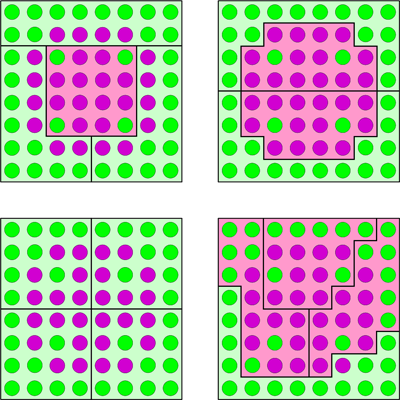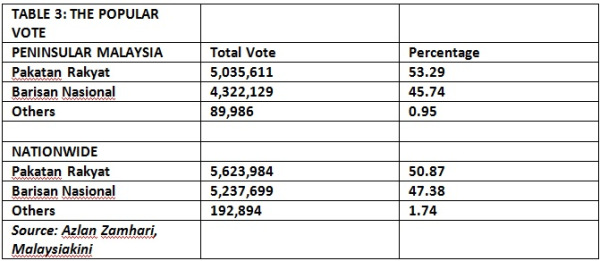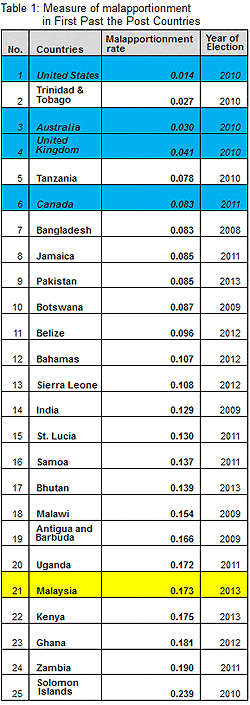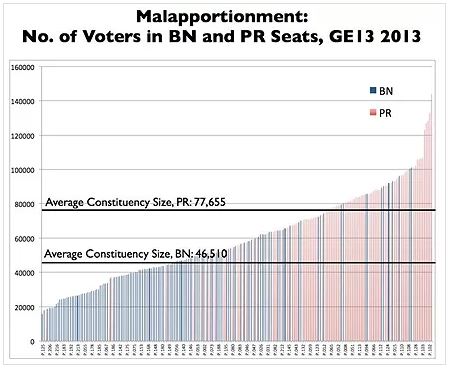It is now about three months ago that the 13th General Election was held in Malaysia. Time for some comments, primarily for my non-Malaysian followers, although there might also be something new for my Malaysian friends..:-)
As I wrote in my post GE13: the Results , the ruling BN coalition remained in power, although with a reduced majority (133 against 89 for the opposition), but they lost the popular vote.
In the weeks following Election Day, numerous protest demonstrations were held, all over the country. Aric attended the biggest one, in Kelana Jaya and came home, deep in the night, full of enthusiasm: “There were people from all races and all ages. I really felt that I was a Malaysian“. He took this picture:
Prime Minister Najib’s first reaction was about a Chinese Tsunami. Newly-appointed Home Minister Datuk Seri Ahmad Zahid Hamidi said Malaysians who are unhappy with the country’s political system should leave the country. But it was not a Chinese tsunami, it was a result of the urban-rural divide.
There were more intelligent responses. Nazri, now minister of Tourism, in an interview with the Malay Mail, about the reduced support for BN: This is the tragedy of education. You keep them stupid, so they will keep you in government or you educate them and risk having them go against you. To be fair to him, he added: I will still choose the latter.
I will now try analyse the election results a bit. Let me recapitulate what I explained in my earlier post GE13. Malaysia uses a District System for the elections, instead of Proportional Representation. Two “dangers” in a District System are gerrymandering and malapportionment. Districts (constituencies) should have more or less the same size, if that is not the case, there is malapportionment. Even when they have the same size, you can still have gerrymandering. I found this very clear example of gerrymandering on the Internet. It shows four districts, equal in size, with two parties, Green and Purple. Counting the dots (voters), you will find 36 Green and 28 Purple. So Green would have a majority in a PR system.
In a District System the outcome depends strongly on the boundaries of the districts.
 Lower left: in all four districts Green wins
Lower left: in all four districts Green wins
Upper left: three Green districts, one Purple,
Upper right: two Green, two Purple,
Lower right: one Green, three Purple, so Green even looses!!
The delineation makes all the difference!
I have no idea how much gerrymandering is taking place in Malaysia, but the malapportionment is very obvious and in the rest of this blog I will concentrate on it.
Last week Malaysiakini published an article about malapportionment. In a list of 25 countries that use the District system, Malaysia takes a shameful 21st place, between Uganda and Kenya.
The reason is clear. In most countries there are rules for the relative size of districts. For example in the UK there can be no more than 5% difference with the national quota, where the national quota is defined as the number of voters divided by the number of MP’s
Malaysia had these rules too, but they were relaxed and finally completely abolished by the BN government.As a result in the last election, in the state of Selangor the Kapar district had 144159 voters and the Sabak Bernam district 37318. The national quota in the GE13 was 48927, so Kapar is ~ 195% more and Sabak Bernam ~ 25% less
Almost unbelievable!
In discussions with my Malaysian friends often even more extreme examples are given, for example the Igan district in Sarawak with 17771 voters or, the most extreme, Putrajaya Federal Territory with 14345 voters, TEN times less than Kapar.
Here is a graph of all 222 constituencies ordered by size. Notice the huge difference in size, but especially that the constituencies where the Government (BN) won are on average a lot smaller than those where the Opposition (PR) won!
A far cry from the One Man, One Vote principle! Of course after the election many people calculated how the result would have been if all votes would have had equal weight. Here is the result, taking Malaysia as a whole, if there would have been Proportional Representation. Not a majority for BN, but a clear win for the Opposition. The “real” election results are given for comparison, in orange.
| Total voters | Seats | Quota | BN | BN seats | PR | PR seats | |
| Malaysia | 10861683 | 222 | 48927 | 5237699 | 107|133 | 5623984 | 115|89 |
Understandable that there was a lot of unrest and protest after the election, as many people felt that BN had no moral right to form a new government. However, the calculations given above are NOT correct, as I will explain now.
We have to go back to 1963, when Singapore, Sabah and Sarawak were considering/asked to join the newly (1957) formed Federation of Malaya. They were worried that they would be overwhelmed by the Peninsular states. As a safeguard it was agreed in the negotiations that the the three states would get 1/3 of the seats in Parliament, so for constitutional changes their consent would be needed. In 1963 the Federation of Malaysia was formed and the Parliament had 159 seats, 104 for Malaysia and 55 for the new states. A few years later Singapore decided to leave the Federation. And later the Federal Territories were created, first Kuala Lumpur (1974), then Labuan 1984) and finally Putrajaya (2001). In the present Parliament, Peninsular Malaysia has 153 seats, East Malaysia 56 and the three Federal Territories 13. Therefore East Malaysia has only ~ 25% of the seats in Parliament, less than 1/3, and many Sarawakians and Sabahans are unhappy with that!
Back to the elections. It will now be clear that the calculation of a national quota does not make sense in Malaysia, as it consists of three separate entities. For each of them we have to calculate the quota, and then we can for each of them calculate what the result of proportional representation would be! The results are given in this table:
| Total voters | Seats | Quota | BN | BN seats | PR | PR seats | |
| Peninsular Mal. | 8690785 | 153 | 56803 | 4084928 | 72|82 | 4605857 | 81|71 |
| East Mal. | 1484784 | 56 | 26514 | 902866 | 34|47 | 581918 | 22|9 |
| Federal Terr. | 686114 | 13 | 53180 | 249905 | 5|4 | 581918 | 8|9 |
| Malaysia | 10861683 | 222 | 5237699 | 111|133 | 5623984 | 111|89 |
The three quota are in yellow. The quota for Peninsular Malaysia and the Federal Territories are in the same range, the quota for East Malaysia is much smaller, reflecting the special position of Sabah and Sarawak. For all three the number of seats is calculated according to proportional representation (light-blue) with the actual results in orange for comparison.
It is clear that in Peninsular Malaysia and the Federal Territories the opposition wins convincingly. But it is also clear that in East Malaysia BN wins convincingly, even with proportional representation! And because of the different weight factors, we come to a surprising final result: BN and PR would hold each other in balance, a hung Parliament, LOL.
Congratulations if you have been following this blog until here..:-) It has taken me many days to get a clear view of the situation.
A few concluding remarks
1. The numbers have been taken from this very accessible and detailed website: Malaysia Election Data
2. In many states a relatively small number of votes has been given to Independents etc. In total about 1.74%. None of these candidates got a seat. Also in proportional representation none of these candidates would get a seat. Therefore in the above calculations I have neglected those votes.
3. When you compare sizes of constituencies to show malapportionment, you must do that within each of the three entities. It makes no sense to compare Kapar and Putrajaya.
4. It is clear that the battle between government and opposition has to be fought in East Malaysia. East Malaysia is still the “fixed deposit” of the BN government.
5. The Election Commission will start a Delineation Exercise soon. For changing the number of seats a 2/3 majority is needed, for just delineation a simple majority is enough. The EC should be completely independent of the government, but the communis opinio in Malaysia is that EC and the government (BN) work hand in hand.
6. My bet is that the EC will propose to increase the number of seats for East-Malaysia, and as compensation for the opposition, split a few of the large constituencies in Peninsular Malaysia.




